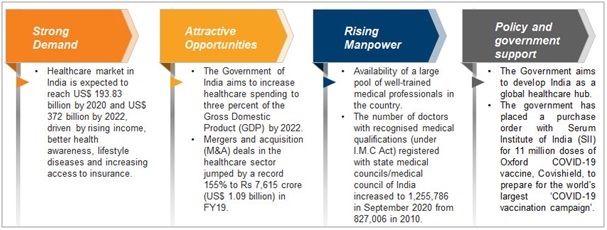

In Budget 2021 health sector is focused on by Government, which was severely hit by the unprecedented pandemic. The focus has been laid on healthcare and infrastructure with an eye on achieving the vision of Atmanirbhar Bharat.
Context
In Budget 2021 health sector is focused on by Government, which was severely hit by the unprecedented pandemic. The focus has been laid on healthcare and infrastructure with an eye on achieving the vision of Atmanirbhar Bharat.
Background
- The unprecedented COVID-19 pandemic has completely changed the situation no one could ever imagine. Almost all aspects of society have witnessed disruptions.
- However, every challenge comes with various opportunities, so does this pandemic.
- It has opened a wide window of opportunities to restructure and reform the Indian health industry which has been in a bad state of repair.
- Underscoring the significant importance of health and wellbeing for the growth and development of the country, the Budget allocation for the same was increased to ?2,23,846 crore in 2021-22 as against this year's ?94,452 crores, according to an official release.
- This manifests into an increase of 137%.
Analysis
Assessing Indian Healthcare Industry
- In India, the Health care sector is one of the largest sectors in terms of both revenue and employment.
- In India, the health care sector can be categorized into public and private.
- Public health care hospitals comprise secondary and tertiary care institutions in urban areas while primary basic facilities are focused in rural areas.
- Private health care sectors provide secondary, tertiary, and quaternary services in metro cities.
Healthcare Industry in India

What are the issues and concerns of the Sector?
India’s health care sector has achieved some positive achievements on the health indicators but suffers some serious shortcomings in care delivery.
|
RIGHT TO HEALTH
|
- Inadequate reach: The inadequate reach of basic healthcare services, shortage of medical personnel, quality assurance, the inadequate outlay for health, and most importantly insufficient impetus to research.
- Inadequate Fund: The inadequate fund allocation by the administrations is one of the grave concerns.
- Optimal Insurance: The concept of health insurance is still not clear in India and the market is still virgin.
- No focus on Preventive Care: In India, there is a very low emphasis on preventive care, which can be proved very effective in solving a lot of problems for the patient in terms of misery or financial losses.
- Less emphasis on Medical Research: In India, there is no much impetus is being given to R&D and cutting-edge technology-led new initiatives. Such technologies could be useful in an unprecedented situation like Covid-19.
- Issue of Policymaking: For providing effective and efficient healthcare services policymaking is certainly an important aspect. In India, the problem is fundamental of supply than demand, where policymaking can be effective.
- Shortage of Medical Workforce: In India, there is a shortage of doctors, nurses, and other staff in the health sector. As per a report laid down by a minister in Parliament, there is a shortage of 600,000 doctors in India.
- Inadequate outlay for health: As per National Health Policy 2002, India contributes only 0.9 percent of its GDP to the Health care sector.
- Lack of structure: Private hospitals are expensive and public hospitals are either not enough for the Indian Population or lack the basic facilities.
Opportunities in Health Care Sector
- Indian health care sector is expected to increase to Rs. 8.6 trillion (US$ 133.44 billion) by 2022. It is almost three times which is what it’s now in present.
- Data Analytics: With the arrival of the National Digital Health Mission (NDHM), the digital Health ID will come which will store the data of patients. It would help in effective policymaking and private players can get an edge in introducing the new technologies in the market.
- Private investments: With the advent of information technology and big data it would be easy for private players to invest strategically.
Ayushman Bharat Scheme
- It is the largest health scheme in the world.
- It would primarily target the poor, deprived rural families and identified occupational category of families as per the latest Socio-Economic Caste Census (SECC) data for both rural and urban areas.
- The expenses incurred will be shared between Centre and States in a 60:40 ratio.
- Employment opportunity: As we know Indian health care sector lacks a workforce, there is a space for thousands of employees.
- Start-ups: With the help of Government and private players an environment of start-ups and entrepreneurship can be created in this field.
- Medical Tourism: India is already one of the favorite medical Tourism Destinations in the world and in the upcoming years this sector can be harnessed efficiently.
|
Government Initiatives
|
What measures are required in the sector?
- Improving infrastructure: There is a need of improvising the infrastructure of public hospitals which have a lot of burden due to the high population in India.
- Focus on private hospitals: Private hospitals must be encouraged by the government because their contribution is important. Private sector also needs to participate because the challenges are significant and these cannot be resolved only by the government alone.
- Efficiency enhancement: More medical personnel must be recruited to enhance the capabilities and efficiency of the sector.
- Technology utilisation: Technologies must be used to connect the dots in the health system. Medical devices in hospitals/ clinics, mobile care applications, wearables, and sensors are some forms of technology that should be added in this sector.
- Awareness: People should be made aware of early detection and preventive care. It would help them in saving pocket expenditure also.
Conclusion
The year 2021 could be the year when India consolidates and expands on its social determinants of health (SDH) approach. India now needs to sustain its current interest in strategic health policy as a key pillar of the economy.


